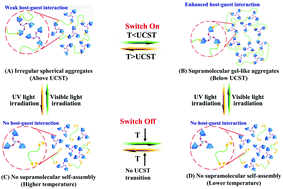A light-tunable thermoresponsive supramolecular switch with reversible and complete “off–on”/“on–off” conversion†
Abstract
Stimuli-responsive polymers have been widely used to design switchable materials and endow them with a “switch on” function with response characteristics. However, in some cases, the switch needs to be completely switched off even though the external environment changes in specific applications. Herein, we report the first example of a phototunable upper critical solution temperature transition of a binary/ternary supramolecular host–guest system for use as a thermoresponsive supramolecular switch for detecting temperature changes. The obtained supramolecular switch easily achieved reversible and complete “off–on”/“on–off” conversion of a temperature switch function under alternating UV/visible light irradiation. The smart supramolecular switch as a novel laser sensor device was used to detect temperature changes through an “off–on” or “on–off” mode. This study demonstrates an approach for constructing a new generation of smart materials or switchable materials based on supramolecular systems.



 Please wait while we load your content...
Please wait while we load your content...